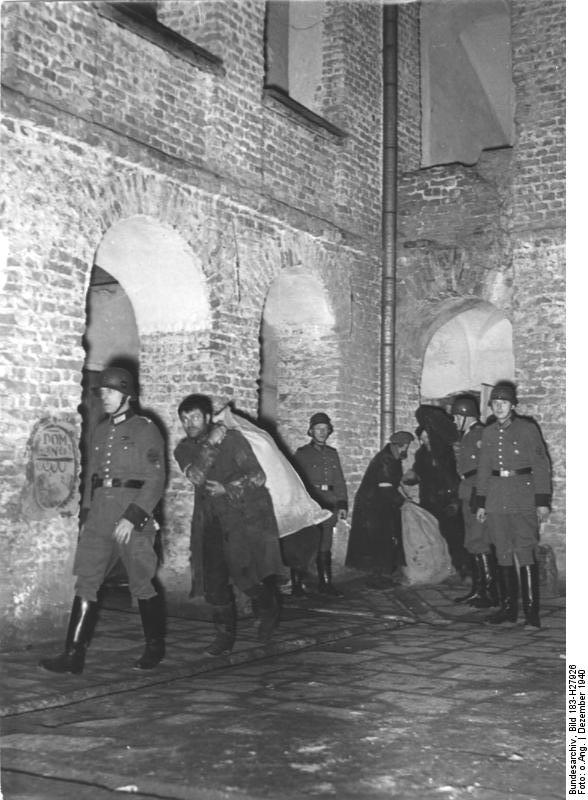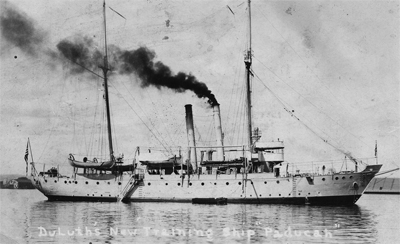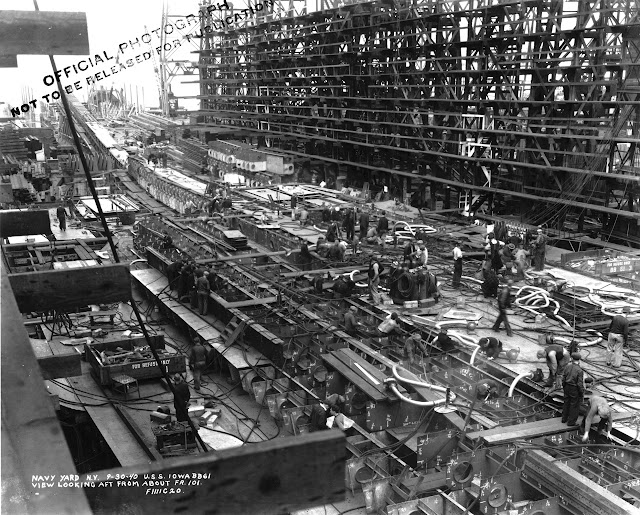Thursday 12 December 1940
 |
| "'Boche-Buster', a 250-ton 18-inch railway gun, Catterick, 12 December 1940. The gun later traveled down to Kent to take up a position at Bishopsbourne on the Elham to Canterbury Line, taken over by the Army for the duration." © IWM (H 6089). |
British 7th Armored Brigade heads through the desert to outflank Sollum and cut the road to Bardia. Sollum, which appears inconspicuous on the map, actually is extremely important to the British because it has a small port, and the Royal Navy has complete control of the sea and can use it to supply further advances.
The Italians leadership is in a panic. Marshal Graziani signals Mussolini that Libya may be next to fall, and Italian troops may be required to withdraw the 10th Army all the way to Tripoli.
Altogether, the Italians have lost 38,289 troops. Some of these are dead and wounded, but the vast majority are taken as prisoners. They also lose 73 tanks, 237 guns, 1000 other vehicles - and all of Egypt+. The British to date have lost 634 casualties and no equipment.
The RAF operates offensively against the Italian bases in Libya. Blenheim bombers based in both Malta and Alexandria raid Castel Benito, Benina and El Adem. They are virtually unopposed, as the Italian Fiat CR 42 biplane fighters are brushed aside by the modern RAF Hurricanes.
The RAAF retires its Gloster Gauntlet Mk II fighters, which have been effective recently in ground attacks in Egypt (against virtually no opposition) but are obsolete and difficult to maintain.
 |
| "Three 12-inch railway guns at Catterick, 12 December 1940." © IWM (H 6123). |
European Air Operations: While officially the Battle of Britain may be over, for many in England this month is the worst bombing experience they yet have faced. It only seems to be getting worse, too, with the shorter days giving the Luftwaffe plenty of nighttime hours to launch carefully planned attacks.
The Luftwaffe returns full force tonight. KG 100 leads off with 13 Heinkel He 111s, followed by literally hundreds of Junkers Ju 88, Heinkel, and Dornier Do 17 bombers. Altogether, 280-336 bombers (accounts vary) attack Sheffield throughout the night in three main waves, winding up their attacks at 04:00. However, the bombers miss the center of town, and there are no reports of extensive damage to militarily or economically vital facilities. That said, the city is a mess, with transportation crippled and many left homeless.
This is a continuation of the Germans' most recent strategy of targeting mid-sized cities and towns rather than just focusing on London and Liverpool. As with many of these raids, the citizens can expect a follow-up raid, whether it be tomorrow night or several nights hence. This is the first night of the "Sheffield Blitz."
The Luftwaffe also mounts smaller raids at London, Liverpool and many smaller towns throughout the country. The Luftwaffe loses less than a handful of bombers.
This attack is particularly interesting because the British, as at Coventry, have some idea that it is going to take place. During the day, British monitoring stations detect X Verfahren radio beams, and British military intelligence correctly assesses that they cross at Sheffield. However, as at Coventry, no special precautions are taken such as warnings or evacuations.
The RAF authorizes "Operation Intruder" in Operational Instruction No. 56. These will be night attacks on Luftwaffe airfields by Blenheim Mk 1F fighters of RAF No. 23 Squadron.
The Royal Navy (monitor HMS Terror, gunboats Aphis and Ladybird, and battleships Ramillies and Warspite) bombards the Italian bases in Libya before sunrise. Several of these ships then return to Alexandria. Aircraft carrier HMS Illustrious - a thorn in Mussolini's and Hitler's side - sends aircraft to bomb Italian barges at Bardia.
The Royal Navy has another big task now: evacuating all the Italian POWs from Egypt. Destroyer HMS Janus begins the process, taking 200 POWs from Mersa Matruh to Alexandria. Destroyer HMS Juno also embarks 450 Italians. The Mediterranean fleet begins sending other ships such as HMS Chakla, Fiona and Protector to Sidi Barrani for the same purpose.
RAF ace Douglas Bader is awarded the Distinguished Flying Cross (DFC) for his services during the Battle of Britain. His unit has compiled 62 aerial victories.
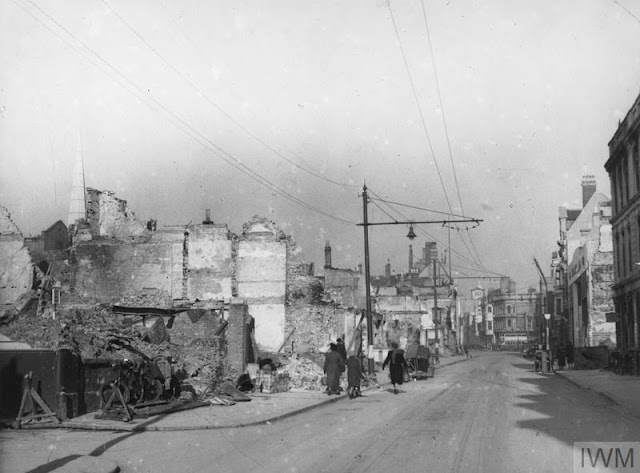 |
| "Southampton was hit by two serious raids on the nights of 23 November and 30 November. During the second of these raids, which lasted six hours, 800 high explosive bombs were dropped. The Auxiliary Fire Service (AFS) was short of firefighters and reinforcements had to be brought in from other areas. The water, gas, and electricity supplies were cut off in many areas. The city's authorities struggled to cope with the aftermath of this raid and its municipal leaders were widely criticized." "Lower High Street, Southampton after the air raids of 30 November and 1 December 1940." © IWM (ZZZ 8205C). |
Battle of the Atlantic: U-96 (Kplt. Heinrich Lehmann-Willenbrock) continues its successful attacks on Convoy HX 92 about ten miles south of St. Kilda, Hebrides. Having sunk two ships yesterday (the Rotorua and the Towa), the U-boat remains perfectly placed to wreak more devastation on the convoy. The rough winter weather provides excellent cover for those U-boats which can ride it out and mount attacks.
At 01:56, U-96 torpedoes and sinks 4575-ton Swedish freighter Stureholm (Master John Olof Gunnar Berner). The ship is loaded with 6850 tons of steel and scrap iron and sinks in only 11 minutes. While Lehmann-Willenbrock observes the 30/32-man crew launch four lifeboats, nobody on the ship ever is found. The Stureholm, incidentally, had survived Convoy HX 84, which had been attacked by Admiral Scheer on 28 October 1940. Stureholm picked up 65 survivors that night, but tonight the crew is not as fortunate.
At 04:31, U-96 is behind the convoy when it sights straggler Belgian 5227-ton phosphates freighter Macedonier. One torpedo is enough to send the ship to the bottom. There are four deaths and 43 survivors. The survivors are spotted by an RAF patrol aircraft, which guides Icelandic ship Súlan to rescue them.
The rough seas are almost as much a danger to the convoys as the U-boats. In Convoy HX 91, 5168-ton Greek tanker Dionyssios Stathatos loses its rudder (a fairly common event this month) in the Northwest Approaches, and the crew abandons it. Since it is never seen again, the Dionyssios Stathatos is presumed to have foundered somewhere in the Atlantic.
Danish fishing boat Margrethe hits a mine and blows up in the North Sea off Sylt, Germany.
Convoy OB 258 departs from Liverpool, Convoy FN 358 departs from Southend, Convoy BS 10B departs from Suez.
U-147 (Kapitänleutnant Reinhard Hardegen) is commissioned.
USS Claxton (DD 140) is recommissioned as HMS Salisbury (I-52) pursuant to the September destroyers-for-bases agreement.
Royal Navy submarine HMS Urge and minesweeper HMS Romney are commissioned.
Destroyer HMS Martin is launched.
 |
| "View: a group of sailors lowers a large mine down through a hole in the surface of the ship's deck." © IWM (Art.IWM ART LD 1372) (War Artists Advisory Committee commission artist: Muirhead Bone). |
Several things stand out about Lord Lothian's tenure:
- He was the prime mover behind Lend Lease, and it was Lord Lothian who planted the idea of unlimited credit in President Roosevelt's mind (and Roosevelt is on the record as contemplating the idea by this date);
- He was the only member of the British government during his lifetime to take affirmative steps (in July 1940) to explore any avenues of peace (which irritated Churchill, who immediately put a stop to it);
- He brought up the delicate subject of Great Britain's looming bankruptcy, making everyone unequivocally aware of England's financial issues (on 23 November 1940), causing temporary consternation in the financial markets but getting the issue front and center so it could be solved.
I am very certain that if he had been allowed by Providence to leave us a last message he would have told us that the greatest of all efforts to retain democracy in the world must and will succeed.In some ways, Lord Lothian was not a "team player" in the sense of marching in lockstep with the Foreign Office. However, he was extremely farsighted, a realist who knew what should be done and did it (albeit not always in the most tactful way) regardless of what his superiors felt was tactful. He "advanced the ball" when it needed to be done. Largely forgotten, Lord Lothian was one of the Allies' unsung heroes of World War II.
Spy Stuff: Having received the secret papers recovered from freighter "Automedon" in the Indian Ocean, German Ambassador to Tokyo Admiral Wenneker gives a copy to Vice Admiral Kondo, Vice Chairman of the Japanese Naval General Staff. The documents are Top Secret assessments by the British War Cabinet regarding British defenses in the Pacific (Hong Kong and Singapore, primarily) and the British negotiating posture in the theater: appeasement.
Needless to say, these papers are of inestimable value to the Japanese, and they are extremely appreciative. Admiral Wenner writes in his diary:
Kondo repeatedly expressed to me how valuable the information in the War Cabinet memorandum was for the navy. Such a significant weakening of the British Empire could not have been identified from outward appearances.This information swiftly goes to the Japanese naval attaché in Berlin, Captain Yokoi, per Hitler's orders (a copy has been sent to Berlin on the trans-Siberian railway). Yokoi sends a condensed version to Tokyo, which the US intercepts but can't decipher until 1943. Many consider this German/Japanese intelligence coup to be a major step toward war in the Pacific. Even if the Japanese would have attacked the western powers on the same date, this intelligence certainly affects Japanese planning on how and where they attack.
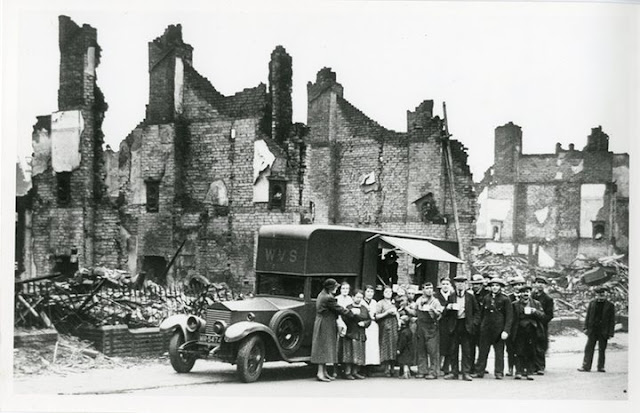 |
| A mobile canteen operated by the Women's Voluntary Services, Sheffield, Yorkshire, 12 December 1940. (Source: The Guardian). |
Hungarian/Yugoslavian Relations: While Yugoslavia is unwilling yet to sign the Tripartite Pact with Germany, it inches slightly closer to doing so. Cvetkovic's Yugoslavian government and Teleki's Hungarian government sign a "Treaty of Eternal Friendship" with Hungary. Hungarian Foreign Minister Count Csaky arrives in Belgrade for the signing, greeted by Yugoslav Foreign Minister Aleksandar Cincar-Markovic. They sign the treaty at the Hungarian Embassy, and it provides:
They wish to place their neighborly feelings, mutual esteem, and confidence on a solid and durable basis which will serve their mutual interests and Danubian peace and prosperityGiven that Romania at this point essentially is a German satellite, this is an indication of which way Yugoslavia may be heading - but it isn't quite in the German orbit yet.
German/Spanish Relations: The German Ambassador to Madrid sends Foreign Minister Ribbentrop a lengthy telegram marked "Strictly Secret." It recounts the 7 December meeting between Admiral Canaris, head of the Abwehr, and Generalissimo Franco. The report notes that Franco refuses to enter the war for the following reasons:
- The British would seize the Canary Islands, Azores, Madeira, the Cape Verde Islands, and Guinea;
- Spain has insufficient foodstuffs and transports for war, particularly of rail cars to support troop movements;
- Imports are insufficient for military preparations due to the war situation;
- Even if the Canary Islands were not invaded, they have supplies for only six months, and they could not be re-supplied.
The report reveals why General Keitel canceled all preparations for Operation Felix, the proposed assault on Gibraltar, so abruptly on 10 December. It also suggests why Hitler also found his meeting with Franco at Hendaye on 22 October so frustrating. Franco's bad-mouthing of his country's capabilities is simply a veil for his covert reasons for avoiding collaboration with Germany.
The real reason for Franco's unwillingness is revealed in contemporaneous internal Spanish military documents. They quite shrewdly conclude that the Axis is in no position to defeat the British at this time and that only the capture of Alexandria would shift the balance of power in the Mediterranean. This same sort of political calculation will recur with Finnish Marshal Mannerheim in two year's time when he similarly demurs on aggressive action until the Wehrmacht removes Leningrad as a Soviet redoubt. Recent Italian reversals in Albania and now Egypt similarly have cast shadows upon Axis prospects over the long term.
German/Vichy French Relations: Hitler invites Marshal Philippe Pétain to attend a ceremony in which Napoleon II's remains are to be reinterred from Austria to the Les Invalides cemetery in Paris, France.
Vichy French/Japanese Relations: The French officially recognize the state of Manchukuo, the Japanese-backed puppet state that presumes to be the government of all of China.
British Military: Sub-Lieutenant Peter Victor Danckwerts, RNVR, receives the George Cross for disarming 16 mines in 48 hours after only five weeks of training and experience. The war is full of such men not really knowing what they are doing - but doing it anyway, at great personal hazard, because it needs to be done.
Rear Admiral John M. Smeallie, Commandant Sixteenth Naval District and Commandant Cavite Navy Yard (Philippines), attempts suicide and is hospitalized. The Navy orders him transferred back to Mare Head, California. Many histories refer to this incident euphemistically as Smeallie's "incapacitation." This is the first in a series of command "incidents" at Cavite over the next year which seriously impairs its preparation and functioning despite the best efforts of Four Star Admiral Thomas C. Hart. Hart, incidentally, is temperamentally unsuited to work with General Douglas MacArthur (or vice versa), the dominant US presence in the Philippines. This presents additional challenges which eventually will bear extreme consequences.
German Military: The first draft of Directive 21, the plans for the invasion of the Soviet Union, are completed today and submitted to General Jodl. This draft has the codename "Fritz." The name Fritz is chosen because it is the name of planner Lieutenant Colonel Bernhard von Lossberg's eldest son and basically is just a placeholder. Hitler is not going to leave Fritz as the codename for long.
The planning process for what turns into Operation Barbarossa is convoluted and confuses even experts. There actually are two entirely different plans being prepared. This is the OKW (Military High Command) plan; the OKH (Army High Command) also has its own plan, which it presented to Hitler on 5 December. The OKH plan basically has three axes of advance, or prongs, in the north, center, and south of the front, but with the greatest emphasis on the central (Moscow) line of advance. The army generals feel that Moscow is the most important objective in the Soviet Union and should be taken first.
This version of the invasion, the OKW/Hitler plan, shifts greater weight to the attacks on Leningrad and Kyiv. The Army plan, while not the "official" plan, is being used by the army for logistical planning purposes regardless of what the OKW (and, by extension, Hitler) intends. This may seem like a subtle distinction, but, as an example or perhaps an exaggeration of what is going on, the army is putting its best divisions where it wants to strike - toward Moscow - in favor of weaker forces heading toward Hitler's objectives further north and south.
In essence, there are two completely separate plans being prepared, and internally the army is disposing of its forces in favor of its own plan - changes which for all intents and purposes will decide what actually happens during the invasion. In other words - the army covertly is ignoring what Hitler is going to issue in his upcoming directive. There will be insufficient time to reallocate forces once the army has them in position for its own plan, and, in any event, it would be extremely inefficient to shift things around once the troops are at their jump-off points.
That said, not all of the army generals favor the army's plan, as they also think the main weight of the advance should be in the north, to link up with the Finns at Leningrad and then head south to Moscow. The southern prong, though, raises little enthusiasm in anyone besides Hitler, who is lusting after the economic resources there.
Hitler eventually realizes what is going on - when isn't entirely clear - and tells the army leaders that they can start out with their plan, but once the boots are hitting the ground and early gains are made, his plan will take over and the army group weightings will shift. Those who view Hitler as an all-powerful warlord in control of everything going on in his military may not grasp the subtle undermining of his intent throughout the Operation Barbarossa planning process.
Looking ahead, this goes a long way toward explaining Hitler's growing resentment toward his generals as a group and will explain why some generals seemingly inexplicably are dismissed and replaced (such as Fedor von Bock - but we'll get to that down the road) on what otherwise seems to be a whim. It also will go a long way toward explaining what cripples the German invasion in August 1941.
Separately, the 102 Infanterie Division is formed in Wehrkreis VIII from parts of the 8 and 28 Infanterie Divisions. It becomes part of the XX Korps/11th Army.
 |
| "The shell hoist of 'Boche-Buster', a 250-ton 18-inch railway gun, Catterick, 12 December 1940. The gun later traveled down to Kent to take up a position at Bishopsbourne on the Elham to Canterbury Line, taken over by the Army for the duration." © IWM (H 6091). |
South Africa: General JBM Hertzog resigns from the South African government. He had been the prime proponent of a neutral stance in the war, but that has proven to be an unpopular position within the government. Jan Smuts, his former coalition partner, now leads the South African government. Following his replacement, Hertzog tried to form a new coalition with Daniel Malan's opposition Purified National Party to create the Herengde Nasional Party. However, Hertzog stood for equal rights between British South Africans and Afrikaners, and that was unacceptable to his erstwhile partners.
British Homefront: Reports are arising once again that the evacuation schemes put in place by the government (Operation Pied Piper) are being thwarted by families and the evacuated children themselves. During the war's first winter, children are getting homesick and parents are bringing their children home for the holidays - to stay permanently, despite the danger.
The evacuations, incidentally, are not free - the children's parents must pay every week 10 shillings and sixpence (53p; equivalent to £27 today, roughly $35) for the first unaccompanied child, and 8 shillings and sixpence for any subsequent children. The host families - many of whom have no choice but to accept children - theoretically use those sums to provide for the evacuees. While it is tempting to view host families as only too happy to shelter endangered children, human nature intrudes at every turn, and many host-evacuee relationships are disasters. All of this means that children are finding their way back into their at-risk cities right when the Luftwaffe is mounting some of its most effective and devastating attacks.
Future History: Marie Dionne Warrick is born in East Orange, New Jersey. Her family is heavily involved with the Drinkard Singers, a family gospel group that even Elvis Presley once asks to serve as his backup group. Marie loves to sing. She finishes high school in East Orange in 1959, then attends the Hartt College of Music in Hartford, Connecticut. She lines up some session work in New York City, and while doing so meets songwriter Burt Bacharach. He hires her to record demos of his own songs, and she winds up with a deal with Scepter Records in 1962. She releases her first solo single, "Don't Make Me Over," that year. On that single, purely by accident, Marie's name is misspelled "Warwick," and it sticks. As Dionne Warwick, Marie continues to work with Bacharach and Hal David, recording such hits as "Walk on By" and "Do You Know the Way to San Jose?" Dionne Warwick's success continues to grow, she changes labels (but still works with Bacharach and David), and goes on to a legendary singing career which continues to this day (2016).
 |
| Amazing Stories vol 14 no 12, December 1940. Cover by Robert Fuqua illustrating “Adam Link Fights A War” by Eando Binder. (Sci-Fi Covers.com). |
December 1940
December 1, 1940: Wiking Division Forms
December 2, 1940: Convoy HX 90 Destruction
December 3, 1940: Greeks Advancing
December 4, 1940: Italian Command Shakeup
December 5, 1940: Thor Strikes Hard
December 6, 1940: Hitler's Cousin Gassed
December 7, 1940: Storms At Sea
December 8, 1940: Freighter Idarwald Seized
December 9, 1940: Operation Compass Begins
December 10, 1940: Operation Attila Planned
December 11, 1940: Rhein Wrecked
December 12, 1940: Operation Fritz
December 13, 1940: Operation Marita Planned
December 14, 1940: Plutonium Discovered
December 15, 1940: Napoleon II Returns
December 16, 1940: Operation Abigail Rachel
December 17, 1940: Garden Hoses and War
December 18, 1940: Barbarossa Directive
December 19, 1940: Risto Ryti Takes Over
December 20, 1940: Liverpool Blitz, Captain America
December 21, 1940: Moral Aggression
December 22, 1940: Manchester Blitz
December 23, 1940: Hitler at Cap Gris Nez
December 24, 1940: Hitler at Abbeville
December 25, 1940: Hipper's Great Escape
December 26, 1940: Scheer's Happy Rendezvous
December 27, 1940: Komet Shells Nauru
December 28, 1940: Sorge Spills
December 29, 1940: Arsenal of Democracy
December 30, 1940: London Devastated
December 31 1940: Roosevelt's Decent Proposal
2020




